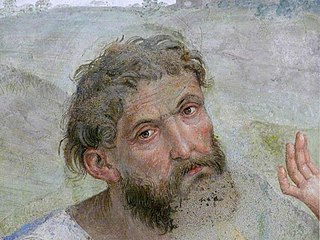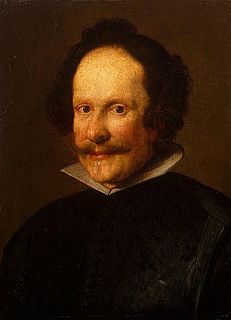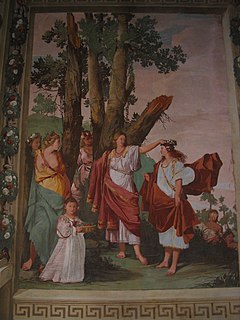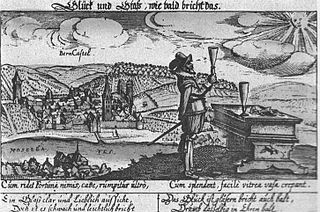
Lo Spagna, "the Spaniard" in Italian, was a painter of the High Renaissance, active in central Italy. His name was Giovanni di Pietro, but he was known as Lo Spagna because he was born in Spain. After Raphael, he was a main pupil and follower of the Umbrian painter Perugino, whose style his paintings develop. He should not be confused with Pietro di Giovanni D'Ambrogio of Siena.

Claudio Coello was a Spanish Baroque painter. Coello is considered the last great Spanish painter of the 17th century.

Alessandro Tiarini was an Italian Baroque painter of the Bolognese School.

Ortolano was an Italian painter of the Ferrara School, active in the Renaissance period. Ticozzi cites his birth as ca. 1480.

Giulio Carpioni was an Italian painter and etcher of the early Baroque era.

Francesco Trevisani was an Italian painter, active in the period called either early Rococo or late Baroque (barochetto).

Francesco Brizio (1574–1623) was an Italian painter and engraver of the Bolognese School, active in the early-Baroque.
Bonaventura Lamberti was an Italian painter of the Baroque period, active mainly in Rome. He was born at Carpi, and after some years working at Modena, he became a pupil of the painter Carlo Cignani in Rome. There, he became attached to the household of the Marchese Gabrieli. In Rome, he painted St. Francis of Paola resuscitating a dead Child for the church of the Spirito Santo de Napolitani. He painted some cartoons used for mosaics for St. Peter's basilica by Ottaviani. His Virgin showing the Infant Saviour to St. Jerome was engraved by Ludovico Dorigny. Among those who worked with him was Marco Benefial. He died at Rome.

Luigi Quaini (1643–1717) was an Italian painter of the Baroque period.
Francesco Capelli was an Italian painter. He was born in Sassuolo in the province of Modena, and was educated in the school of Correggio. He painted a 'Madonna and Child in Glory with attendant Saints' for the church of San Sebastian at Sassuolo. He was also called Caccianemici, but must not be confounded with another Francesco Caccianemici, a contemporary pupil of Primaticcio, and lived about the same period.
Domenico Bettini (1644–1705) was an Italian painter of the Baroque period, mainly depicting still-life subjects.

Cristofano Bertelli was an Italian engraver. He was born in Rimini in the Duchy of Modena. A few of his plates survive: Portrait of Ottavio Farnese, Duke of Parma; Conversion of St. Paul; Holy Family with Saints Augustine, Sebastian, & Helena, with St. Joseph sleeping. Virgin and Child with St. George and other Saints; Virgin and Child, with Saints Sebastian, Francis, and Roch after Correggio; and The different Ages of Man.

Antonio Triva was an Italian painter and engraver of the Baroque period.

Jacopo Zoboli was an Italian painter of the late-Baroque period.

Antonio Begarelli, also known as Begarino (1499–1565) was an Italian sculptor.

Sigismondo Caula (1637–1724) was an Italian painter of the Baroque style.

Ercole dell'Abate or dell'Abbate (1573–1613) was an Italian mannerist painter in his native Modena. In English, his name is sometimes given as Ercole Abbate, Abate or Abati.

Martin Fréminet was a French painter.

Sebastian Furck or Fulcarus (c.1589–1666) was a German engraver.

The church of Santa Maria della Pomposa in Modena, Italy, is an ancient church in the city, once located at the edge of the city walls. Its name derives from the Pomposa Abbey located near the delta of the Po River.

















